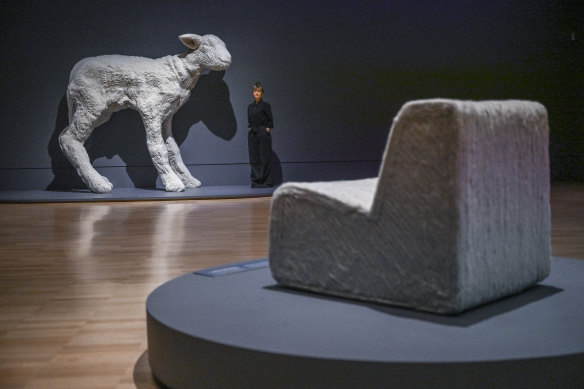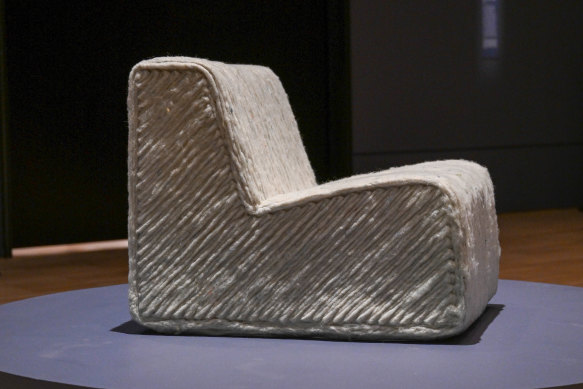This sheep in sheep’s clothing is solving a knotty problem
By Will Cox
In a spartan room at the NGV, the figure of a lamb stands three metres high, elegant, soft and strong. The lamb is crafted from felted wool, the result of a new process developed by Dutch designer Christien Meindertsma.
The recipient of the 2024 MECCA x NGV Women in Design Commission has created a process that turns “waste” wool into a versatile new material.

Designer Christien Meindertsma with two of her new artworks at NGV International.Credit: Joe Armao
“It shouldn’t be called that,” says Meindertsma. To her design sensibilities, the word “waste” is a challenge.
For decades, Meindertsma has been researching and designing with wool as well as other unwanted byproducts like flax and pig products. She has won three Dutch Design Awards, and her work has been displayed in MoMA, New York, and London’s Victoria and Albert Museum.
This project, entitled First there was a mountain, came about as a result of a Dutch shepherd’s unease with the sheer amount of wool he was having to throw away.
Design is about problem-solving. The problem Meindertsma is solving is twofold: “One, we’re throwing good wool away,” she says, “and two, we’re using a lot of polluting materials as filler, for furniture, acoustics, and insulation.”

Christien Meindertsma demonstrates the other potential uses of wool that would ordinarily be discarded. Credit: Joe Armao
Though the huge lamb is the first thing to get your attention, it’s accompanied by two other pieces: a film detailing its creation, from fields on the outskirts of Rotterdam to a shearing shed and machine processing, and a prototype chair, off-white with flecks of colour. The chair is squat and comfortable-looking, and surprisingly solid for something made from 100 per cent wool.
Both the lamb and the chair have been created with the help of the “Wobot”, a 3D-printer-like device with a robotic arm. “The wool is a new material, made from an ancient material,” says Meindertsma. “It can do things you don’t expect wool to do.”
In Australia, wool is a billion-dollar industry. In northern Europe, not so much. The key problem is that all flocks are different, Meindertsma says.

A giant lamb created by designer Christien Meindertsma is on display at the NGV from October 3. Credit: Joe Armao
Wool quality varies, colour varies, and wool prices have dropped so low that there’s little money to be made. Much of the 1.5 million kilos of wool produced in the Netherlands every year is thrown away. Paradoxically, it’s cheaper to import merino wool from Australia and New Zealand to make clothing and other products.
Meindertsma embarked on a “research adventure”. She made prototype clothing and upholstery fabrics with the unwanted wool, and eventually designed the Wobot with the assistance of Dutch manufacturer Tools for Technology. The Women in Design commission allowed her to create a much bigger machine that can produce much bigger outputs, like the lamb.
The Wobot’s process is sustainable, recyclable, and uses no water (after the initial washing stage). Meindertsma hopes it could make environmentally ruinous products like foam rubber obsolete. “The furniture industry is behind,” says Meindertsma. “They point the finger at the foam rubber industry, but they keep using it.”
Meindertsma describes herself as an “investigative designer”, for whom design is about process, and the potential of materials, rather than outcome. She is keen to point out that the lamb, beautiful as it is, is a prototype, not a sculpture. The distinction is important – it’s not just an aesthetic object.
“The lamb displays the technique, but it’s also a learning model,” she says. “It’s very complicated to print, so there are many problems to solve. The process of making the lamb was really teaching the robot.”
Watching the accompanying film, directed by long-time collaborator Roel van Tour, it’s easy to get distracted by the cute lambs as they graze in a field across a highway from a car dealership. “He’s my favourite,” Meindertsma says of one, still wet from birth. He’s minutes old. Human hands massage breath into his lungs. He breathes uneasily and tries to stand, but his legs won’t support him yet.
Meindertsma’s own three-metre lamb also can’t stand on his own yet. His legs are reinforced with metal to support the weight of his torso. But, of course, this is only a prototype.
“I’m still convinced I could make it entirely from wool, if I made a few more sheep to practise,” says Meindertsma. “We’ve got far, but we can get further.”
First there was a mountain will be on display as part of the 2024 MECCA x NGV Women in Design Commission from October 3 at NGV International.
The Booklist is a weekly newsletter for book lovers from Jason Steger. Get it delivered every Friday.